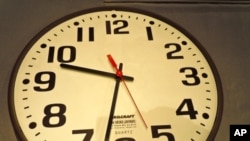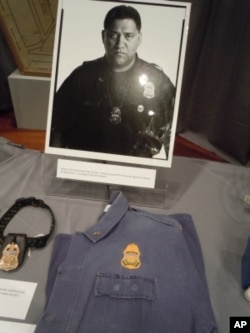A leather briefcase, a little girl’s doll, a handful of coins. These ordinary objects take on extraordinary meaning because of where they come from.
They are among the items recovered from the rubble of the World Trade Center in New York City, the Pentagon and Shanksville, Pennsylvania - the three sites involved in the most devastating terrorist attacks in U.S. history.
There are more than 50 artifacts in the “September 11: Remembrance and Reflection,” exhibit at the Smithsonian's National Museum of American History in Washington, D.C.
The items are laid out, uncovered, on three tables; one for every impacted site. There is also a table bearing newly-obtained objects from the Transportation Security Administration.
The decision to display the exhibit without protective cases was unusual for the Smithsonian, but deliberate, according to museum curator Cedric Yeh.
“We hope that it provides our visitors with a sense of intimacy, and gives them a chance to interact with the objects on a level that isn’t normally available.”
Among the most meaningful pieces in the collection, Yeh says, are materials donated by Isaac Ho‘opi‘i, a Pentagon police officer credited with saving many lives in the immediate aftermath of the attack.
After hearing a report on his patrol-car radio about the terrorist attack on the Pentagon, Ho‘opi‘i rushed to the destroyed portion of the building.
“Not only did he physically help remove people from the building,” says Yeh, “but he used his voice when the fires and smoke got too intense for him to return to the building.”
“He would call out to those still trapped inside the building and say, ‘Follow my voice,’ and just with his voice, people were able to orientate themselves and found themselves escaping the building. He affected so many people’s lives. He is still remembered by those he saved.”
The materials Ho‘opi‘i donated to the exhibit include his uniform, shield, his dog Vito’s collar and shield, a K-9 patch, and a poster of Vito.
Associate Curator Shannon Perich realized just how intense the conditions were in the Pentagon after seeing a handful of melted coins.
“When you see that clump of coins and you understand how hot that fire was, it makes your stomach turn," says Perich. "Those metals that are supposed to protect us, that rebar that is supposed to be strong and sturdy, is twisted like a straw, you began to really understand the power of the impact of when those planes hit.”
She is also moved by the standard-issue Pentagon office wall clock that froze at the moment of impact.
“It bounced off the wall, the batteries fell out and time stopped,” she says.
David Allison, associate director for Curatorial Affairs, is struck by the everyday nature of many of the objects in the display, such as a simple office telephone.
“The phone of the solicitor general, who was in contact with his wife who was on Flight 77, he made his last calls to her on that telephone. And I think being able to see that telephone is like a phone you might have on your own desk, and I think you can begin to envision what your life might be like if that had been your spouse," Allison says.
All fifty-three passengers, six crew members, and five hijackers were killed when the plane crashed into the Pentagon.
At the New York table, a crushed fire truck door is a reminder of the 343 members of the New York Fire Department who were killed trying to rescue people.
Airplane fragments, a seat belt and a personal logbook belonging to flight attendant Lorraine Bay are among the items on display at the Pennsylvania table. Bay was among the seven crew members and 33 passengers who were killed when Flight 93 crashed into a field in Shanksville, Pennsylvania.
"Each object has its own story and they’re connected to real individuals whose lives were changed, because all of our lives were changed,” says David Allison.
Close to 3,000 people lost their lives in the 9/11 attacks. The display provides a place for visitors to remember and share their personal experiences of that tragic day, says museum interim director Marc Pachter.
Pachter expects the items to play a critical role in educating future generations of Americans, those for whom September 11 will no longer be a personal memory.









